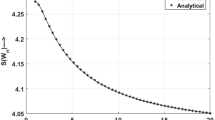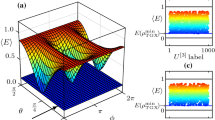Abstract
Preparing the locally maximally mixed (LMM) states is a physically operational work. We investigate the set \(\mathcal{P}_d\) containing two-qudit LMM states. We show that the point with a canonical decomposition (CD) has either the unique or infinitely many CDs. Next we show that the point in \(\mathcal{P}_2\) has infinitely many CDs. Further we construct the necessary and sufficient condition by which the non-extreme point of rank two has the unique CD. We also show that the maximally correlated state of rank d is not an extreme point of \(\mathcal{P}_d\). As an application, we show that if the range of rank-three \(\rho \in \mathcal{P}_3\) is spanned by product vectors, then \(\rho \) is not an extreme point of \(\mathcal{P}_3\). Moreover, \(\rho \) is realizable by unitary channels as a method of constructing a family of two-qutrit LMM states. We also prove that Conjecture 1 in [C. King et al., J. Phys. A: Math. Theor 40, 7939 (2007)] holds for \(\rho \).

Similar content being viewed by others
References
Dong Yang and Yi Xin Chen: Mixture of multiple copies of maximally entangled states is quasipure. Phys. Rev. At. Mol. Opt. Phys. 69(2), 577–580 (2012)
Ishizaka, S., Hiroshima, T.: Maximally entangled mixed states under nonlocal unitary operations in two qubits. Phys. Rev. A 62(62), 578–592 (2000)
Kent, A.: Entangled mixed states and local purification. Phys. Rev. Lett. 81(14), 2839–2841 (1998)
Terhal, B.M., Vollbrecht, K.G.: Entanglement of formation for isotropic states. Phys. Rev. Lett. 85(12), 2625 (2000)
Werner, R.F.: Quantum states with Einstein–Podolsky–Rosen correlations admitting a hidden-variable model. Phys. Rev. A 40, 4277–4281 (1989)
Bennett, C.H., Brassard, G., Crépeau, C., Jozsa, R., Peres, A., Wootters, W.K.: Teleporting an unknown quantum state via dual classical and Einstein–Podolsky–Rosen channels. Phys. Rev. Lett. 70, 1895–1899 (1993)
Ekert, A.K.: Quantum cryptography based on bell’s theorem. Phys. Rev. Lett. 67, 661–663 (1991)
Hillery, M., Buzek, V., Berthiaume, A.: Quantum secret sharing. Phys. Rev. A 59(3), 1829 (1999)
Deng, F.G., Gui, L.L., Xiao, S.L.: Two-step quantum direct communication protocol using the Einstein–Podolsky–Rosen pair block. Phys. Rev. A 68(4), 113–114 (2003)
Long, G.-L., Liu, X.-S.: Theoretically efficient high-capacity quantum-key-distribution scheme. Phys. Rev. A 65(3), 032302 (2002)
DiVincenzo, D.P., Shor, P.W., Smolin, J.A., Terhal, B.M., Thapliyal, A.V.: Evidence for bound entangled states with negative partial transpose. Phys. Rev. A 61, 062312 (2000)
Chen, L., Djokovic, D.Z.: Distillability of non-positive-partial-transpose bipartite quantum states of rank four. Phys. Rev. A 94, 052318 (2016)
Kwiat, P.G., Barraza-Lopez, S., Stefanov, A., Gisin, N.: Experimental entanglement distillation and ’hidden’ non-locality. Nature 409(6823), 1014–7 (2001)
Sackett, C.A., Kielpinski, D., King, B.E., Langer, C., Meyer, V., Myatt, C.J., Rowe, M., Turchette, Q.A., Itano, W.M., Wineland, D.J.: Experimental entanglement of four particles. Nature 404(6775), 256 (2000)
Lin, C., Zhu, H., Wei, T.C.: Connections of geometric measure of entanglement of pure symmetric states to quantum state estimation. Phys. Rev. A 83(1), 99–104 (2011)
Facchi, P., Florio, G., Pascazio, S., Pepe, F.: Maximally multipartite entangled states. Phys.Rev. A 77(6), 060304 (2008)
Flores, M.M., Galapon, E.A.: Mixtures of maximally entangled pure states. Ann. Phys. 372, 297–308 (2016)
Kimble, H.J.: The quantum internet. Nature 453(7198), 1023–1030 (2008)
Streltsov, A., Kampermann, H., Bruß, D.: Quantum cost for sending entanglement. Phys. Rev. Lett. 108(25), 250501 (2012)
Salavrakos, A., Augusiak, R., Tura, J., Wittek, P., Acin, A., Pironio, S.: Bell inequalities tailored to maximally entangled states. Phys. Rev. Lett. 119(4), 040402 (2017)
Huang, Xuan-Lun., Gao, Jun., Jiao, Zhi-Qiang., Yan, Zeng-Quan., Zhang, Zhe-Yong., Chen, Dan-Yang., Zhang, Xi., Ji, Ling., Jin, Xian-Min.: Reconstruction of quantum channel via convex optimization. Science Bulletin, (2019)
Mazziotti, D.A.: Variational minimization of atomic and molecular ground-state energies via the two-particle reduced density matrix. Phys. Rev. A 65(6), 062511 (2002)
Coleman, A.J.: Necessary conditions for n-representability of reduced density matrices. J. Math. Phys. 13(2), 214–222 (1972)
Mazziotti, David A.: Structure of fermionic density matrices: complete n-representability conditions. Phys. Rev. Lett. 108(26), 263002 (2012)
King, C., Matysiak, D.: On the existence of locc-distinguishable bases in three-dimensional subspaces of bipartite 3 Ã n systems. J. Phys. A Math. Theor. 40(28), 7939 (2007)
Horodecki, P.: Separability criterion and inseparable mixed states with positive partial transposition. Phys. Lett. A 232, 333 (1997)
Vianna, R.O., Doherty, A.C.: Distillability of werner states using entanglement witnesses and robust semidefinite programs. Phys. Rev. A 74, 052306 (2006)
Pawel Horodecki, Lukasz Rudnicki, and Karol Życzkowski. Five open problems in quantum information, (2020). arXiv:2002.03233v1
Acin, A., Andrianov, A., Costa, L., Jane, E., Latorre, J.I., Tarrach, R.: Generalized schmidt decomposition and classification of three-quantum-bit states. Phys. Rev. Lett. 85, 1560–1563 (2000)
Chen, Lin: On the locally distinguishable three-dimensional subspace of bipartite systems. J. Phys. A Math. Theor. 51, 14 (2018)
Chen, L., Djokovic, D.Z.: Distillability and ppt entanglement of low-rank quantum states. J. Phys. A Math. Theor. 44(28), 285303 (2011)
Kraus, B.: Local unitary equivalence and entanglement of multipartite pure states. Phys. Rev. A 82(3), 10467–10473 (2010)
Kraus, B., Cirac, J.I.: Optimal creation of entanglement using a two-qubit gate. Phys. Rev. A 63(6), 21–22 (2000)
Chen, L., Li, Y.: Entanglement cost and entangling power of bipartite unitary and permutation operators. Phys. Rev. A 93, 042331 (2016)
Chen, L.: The convex set containing two-qutrit maximally entangled states. Quantum Inf. Process 18(2), 46 (2019)
Hughston, L.P., Jozsa, R., Wootters, W.K.: A complete classification of quantum ensembles having a given density matrix. Phys. Lett. A 183(1), 14–18 (1993)
Wootters, W.K.: Entanglement of formation of an arbitrary state of two qubits. Found. Phys. Lett. 14(3), 199–212 (1997)
Vidal, G., Dür, W., Cirac, J.I.: Entanglement cost of bipartite mixed states. Phys. Rev. Lett. 89(2), 027901 (2002)
Mendl, Christian B., Wolf, Michael M.: Unital quantum channels—convex structure and revivals of Birkhoff’s theorem. Commun. Math. Phys. 289(3), 1057–1086 (2009)
Hosur, P., Qi, X., Roberts, D.A., Yoshida, B.: Chaos in quantum channels. J. High Energy Phys. 2016(2), 004 (2016)
Nengkun, Y., Duan, R., Quanhua, X.: Bounds on the distance between a unital quantum channel and the convex hull of unitary channels. IEEE Trans. Inf. Theory 63(2), 1299–1310 (2017)
Gyongyosi, L., Imre, S., Nguyen, H.V.: A Survey on quantum channel capacities. IEEE Commun. Surveys Tutor. 20(2), 1149–1205 (2018)
Ndagano, B., Perez-Garcia, B., Roux, F.S., McLaren, M., Rosales-Guzman, C., Zhang, Y., Mouane, O., Hernandez-Aranda, R.I., Konrad, T., Forbes, A.: Characterizing quantum channels with non-separable states of classical light. Nat. Phys. 13(4), 397–402 (2017)
Feng, L., Zhang, M., Zhou, Z., Chen, Y., Li, M., Dai, D., Ren, H., Guo, G., Guo, G., Tame, M., et al.: Generation of a frequency-degenerate four-photon entangled state using a silicon nanowire. Quantum Inf. 5(1), 1–7 (2019)
Chaoyang, L., Zhou, X., Guhne, O., Gao, W., Zhang, J., Yuan, Z., Goebel, A., Yang, T., Pan, J.: Experimental entanglement of six photons in graph states. Nat. Phys. 3(2), 91–95 (2007)
Rubino, G., Rozema, LA., Feix, Adrien, Araújo, Mateus, Z., Jonas M., Procopio, Lorenzo M., Brukner, Časlav, Walther, Philip: Experimental verification of an indefinite causal order. Sci. Adv. 3(3), (2017)
Orieux, A., Darrigo, A., Ferranti, G., Franco, R.L., Benenti, G., Paladino, E., Falci, G., Sciarrino, F., Mataloni, P.: Experimental on-demand recovery of entanglemnt by local operations within non-markovian dynamics. Sci. Rep. 5(1), 8575–8575 (2015)
Bryan, J., Leutheusser, S., Reichstein, Z., Van Ramsdonk, M.: Locally maximally entangled states of multipart quantum systems. Quantum 3, 6 (2019)
Bryan, J., Reichstein, Z., Van Raamsdonk, M.: Existence of locally maximally entangled quantum states via geometric invariant theory. Annales Henri Poincaré 19(8), 2491–2511 (2018)
Glancy, S., Knill, E., Vasconcelos, H.M.: Entanglement purification of any stabilizer state. Phys. Rev. A 74, 032319 (2006)
Kruszynska, C., Kraus, B.: Local entanglability and multipartite entanglement. Phys. Rev. A 79, 052304 (2009)
Ri, Q., Ma, Y., Wang, B., Bao, Y.: Relationship among locally maximally entangleable states, \(W\) states, and hypergraph states under local unitary transformations. Phys. Rev. A 87, 052331 (2013)
Gottesman, D.: Class of quantum error-correcting codes saturating the quantum hamming bound. Phys. Rev. A 54, 1862–1868 (1996)
Acknowledgements
This work was supported by the NNSF of China (Grant No. 11871089), and the Fundamental Research Funds for the Central Universities (Grant No. ZG216S2005).
Author information
Authors and Affiliations
Corresponding author
Additional information
Publisher's Note
Springer Nature remains neutral with regard to jurisdictional claims in published maps and institutional affiliations.
Rights and permissions
About this article
Cite this article
Chen, L., Hu, M. Locally maximally mixed states. Quantum Inf Process 19, 305 (2020). https://doi.org/10.1007/s11128-020-02804-4
Received:
Accepted:
Published:
DOI: https://doi.org/10.1007/s11128-020-02804-4




